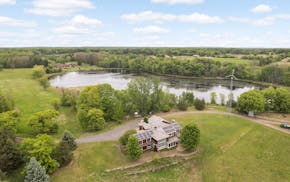Over 16 years as president of the Minnesota Farm Bureau, Kevin Paap had a go-to line whenever he formally introduced himself.
"He would always get to the Farm Bureau title, but first he'd say: 'I'm Kevin Paap, I'm a fourth-generation farmer in Blue Earth County, and I raise corn, soybeans and sons,'" recalled Minnesota Agriculture Commissioner Thom Petersen, who's worked with Paap on farm policy for more than 20 years. "It took you right to where he was coming from."
Next Friday, Minnesota Farm Bureau members gather at a hotel in Bloomington for their 103rd annual meeting. On the agenda is the election of a new president to succeed Paap, who decided not to seek an eighth two-year term.
He'll leave office immediately upon selection of his successor, wrapping up a stint as one of the most influential voices in Minnesota agriculture.
"When I was a younger farmer, I maybe was critical of people who would stay in leadership positions for too long, who didn't want to make room for the next generation of leaders," Paap said in an interview. "In 2005 I seized this opportunity and now I need to remember it's time to let the next generation lead us in these roles."
A state chapter of the American Farm Bureau, the Minnesota Farm Bureau says its members come from about 30,000 dues-paying family farms. County chapters set the dues, which run between about $60 and $90 a year. Like the other major farm policy group, Minnesota Farmers Union, the bureau lobbies state and federal lawmakers on behalf of farmer members and agricultural interests.
In broad terms, the Farm Bureau leans to the right and the Farmers Union to the left, although those distinctions are less sharp than in other industries because of the frequently bipartisan nature of agricultural lawmaking.
Petersen, who serves in the cabinet of Democratic Gov. Tim Walz, previously spent 16 years as chief lobbyist for the Farmers Union.
"I always appreciated Kevin's willingness to find the common good for farmers," Petersen said. "There are states where the two groups don't get along, and that we do has I think been a benefit to Minnesota agriculture."
Two Farm Bureau members, Wright County farmer Dan Glessing and Roseau County farmer Shayne Isane, are competing to succeed Paap. Both offered nothing but praise for his leadership, particularly his commitment to constantly visiting far-flung corners of the state and his insistence that farmers should directly engage in policy discussions.
"One of his favorite sayings is that you have to be at the table or you might be on the menu," said Isane, the director of the bureau's District 7, which covers most of northwestern Minnesota.
Many Farm Bureau members have lifelong associations with the group. Glessing, the current Farm Bureau vice president, recalled how as a kid he would help set up the Farm Bureau booth every year at the Wright County Fair in Howard Lake. The Farm Bureau has an affiliated farm insurance company.
Paap, too, got active early in farm organizations. He was an FFA member in high school, which he said led him to get involved with the Farm Bureau's Young Farmers and Ranchers program. He graduated from college in 1981 and joined the family operation, giving him a close-up look at the farm crisis of the mid-1980s.
"Things were rough. We made it work, we learned a lot," said Paap, who now farms with one of his two sons on the family land in Garden City Township. "You learn a lot in challenging times."
Paap isn't leaving public life. Last year, he was elected to the Blue Earth County Commission. Local politics is in the blood — his grandfather was a longtime mayor of Vernon Center and his father served for 30 years on the township board.
But he's looking forward to less time on the road and more with his two grandsons, who he hopes will be the sixth generation to run the farm.

Minnesota Department of Health rescinds health worker layoffs

Eco-friendly house on 30 acres near Marine on St. Croix listed at $1.6M

DOGE cuts federal money for upgrades at Velveeta plant in New Ulm

